How to Help Your Dachshund Lose Weight (and What to Feed Them)
Maybe you didn’t realize how chubby your Dachshund was getting until yesterday because you didn’t know what your Dachshund should weigh or were in denial.
Or maybe you knew but weren’t ready to do something about it until now.
Maybe it’s because you are in a panic because you just found out being obese can shorten your Dachshund’s life by up to two years.
Whatever the reason, you have come to the right place.
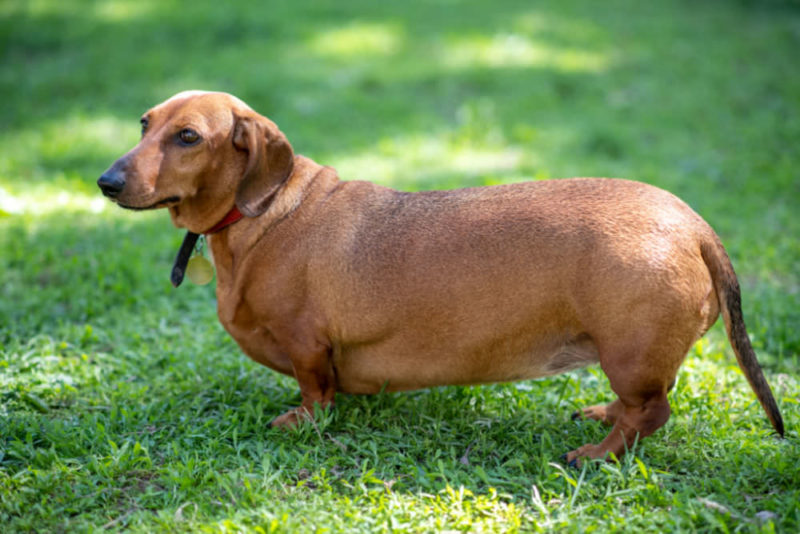
I’m going to provide information that will help you help your Dachshund lose weight.
Why listen to me?
I was shocked when I found out my first Dachshund, Chester, was fat.
He hiked all the time, and “looked fine” to me, but then I spotted a dog body condition chart on the wall at the vet’s office.
I looked at the chart, looked at Chester, looked at the chart again, and said, “Oh, buddy. It looks like you need to go on a diet.
Using some of the suggestions in this article, I helped him to lose 5 lbs over the next 6 months.
I have also been learning about Dachshund weight issues for over 15 years via shared experiences through my Dachshund club members and blog readers.
Your Veterinarian’s Advice is Good But Not Perfect
Veterinarians don’t always speak up when a Dachshund is a bit overweight because it can be a very touchy subject with owners and they don’t want to upset people.
I mention this because sometimes you need to recognize the problem on your own – YOU need to approach THEM about your Dachshund’s weight issue.
If your Dachshund needs to lose weight, especially a lot of it, the first place you should usually look for advice for your dog is a veterinarian.
Important things to ask your veterinarian are:
- How much weight does your Dachshund need to lose
- What is a healthy rate of weight loss (For example, a half a pound a month?)
- Are there any health issues my Dachshund has that is causing the excess weight?
- How would you suggest I change my Dachshunds diet and exercise routine to help them lose weight? *
However, personal experience has taught me that their recommendations about food and exercise are not always accurate for the Dachshund breed. That’s why I put an asterisk by the last question.
Diet and exercise are also the two factors that are easiest controlled by you and that make the most difference in a Dachshund’s weight.
Like with people, weight is largely determined by calories in vs calories out.
If one wants to lose weight, they can eat the same and exercise more, exercise the same and eat less, or ideally both.
I have found many veterinarians will immediately recommend a weight loss dog food but those aren’t always the most nutritious and can cause issues like excess gas (due to the fillers) or refusal to eat because a dog doesn’t like the taste.
I’ve also found that many veterinarians underestimate the exercise needs of a Dachshund and how much they are capable of.
Remember: Before you start any weight loss program with your Dachshund, you should discuss it with your veterinarian first.
So let’s look at food/diet and exercise separately.
The First Step: Start Feeding on a Schedule
If you are currently free-feeding your Dachshund – leaving a bowl out all day for them to graze – switch to feeding a fixed amount on a set schedule instead.
Feeding your Dachshund on a schedule has many benefits but the most relevant for weight control are:
- It can lead to obesity if your Dachshund always wants to eat, especially if there is zero portion control
- In multi-dog households, your Dachshund could be hogging the food, consuming more than their share
When you switch to feeding your Dachshund on a schedule, you will know exactly when your Dachshund is eating and how much.
You may find that your Dachshund starts to lose weight with no other changes once they are eating the correct amount of food for their (ideal) weight.
However, for many dogs, and dogs that are more than a pound overweight, or if your Dachshund is already eating on a schedule, this may not be relevant or enough to change your Dachshund’s weight for the better.
Next: Address Your Dachshund’s Weight Loss Diet
The most common question I see about weight loss food for Dachshunds is, “What food should my Dachshund eat to lose weight and how much should I give them at each meal?”
It’s likely that your veterinarian will recommend some brand of weight loss dog food.
This food often simply has less calories per serving.
To reduce the amount of calories, dog weight loss food often replaces more nutritious ingredients like meat and organs with “fillers”.
Common fillers include:
Fiber
This is the primary ingredient added to weight loss food for dogs to reduce the amount of calories.
Fiber will go through your dog’s stomach without being digested and turned into calories while still adding bulk to the food and helping them feel full.
Carbohydrates
Carbohydrates contain less calories per volume than fat.
Some of the fat in dog weight loss food may be replaced with carbohydrates, again, to reduce the calories while maintaining a similar volume of food for your dog to consume.
How to Reduce Your Dog’s Calorie Intake Without Switching Foods
The thing is though, there are ways to decrease the calories your dog is eating on your own.
You don’t have to switch your dog to a diet food, or switch from a food you know they love, for your Dachshund to lose weight.
Advantages of doing it yourself are:
- Your dog can keep eating the same food they like, which is especially important for picky eaters or Dachshunds with sensitive stomachs
- It can save money because weight loss dog food can sometimes cost more
So how do you reduce the calories that your dog eats in order to control their weight?
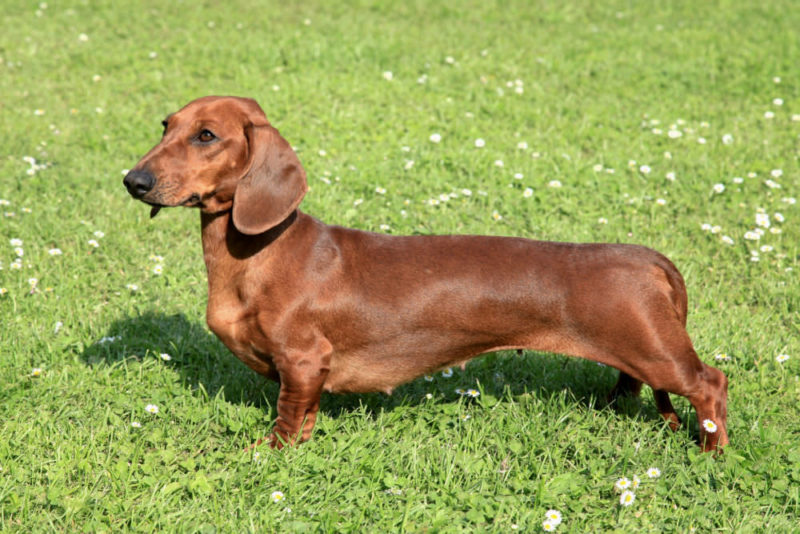
Cut out the treats
The simplest way to reduce your Dachshund calories is to cut way back on, or eliminate, their treats outside of meal time.
This includes any edible chews, dog treats, and table scraps.
You need to make sure the whole household is on board with this temporary routine so someone else isn’t sabotaging your efforts.
There are many calorie-free ways to show your dog you love them.
If you absolutely can’t bear to deny your Dachshund’s pleading eyes and you feed kibble, set a few pieces of kibble aside from their daily portion and feed those as treats throughout the day.
You can also give small pieces of fruits and vegetables as treats like apple, green beans, or cut carrots.
Just make sure the pieces are small and contain few calories. And give them out sparingly!
Feed your Dachshund less
The second, and most impactful way, to cut your Dachshund’s calories is to simply feed them less of their regular food.
If your Doxie eats ½ cup of food twice a day, try reducing the portion of food served at each meal to ⅓.
If your dog normally eats ⅓ cup twice a day, reduce the amount to ¼ a cup.
Doing it this way is effective but doesn’t work for all dogs.
The volume of food in their belly will sometimes leave a Dachshund feeling like they are still hungry.
So what can you do if your Dachshund acts like they’re starving?
How to Help Your Dachshund Feel Full While Eating Less Food
Some Dachshunds may not notice that you are feeding them less at meal times.
My Dachshunds “count” meals by the time there is food in the bowl, not the volume of food in it.
If you are committed to helping your Dachshund lose weight, you’re going to have to resist the temptation when they give you the pleading, sad eyes.
However, some Dachshunds will act like you are being mean and cheating them if you put a few less kibbles in their bowl.
They will act like you are starving them and give you guilty eyes and/or whine for more.
If the latter describes your Dachshund, luckily there are a couple of easy, quick fixes.
The green bean method
You can take a que from the dog food brands and replace part of your Dachshund’s meal with a low calorie, fiber rich food.
This will help your dog to feel like they are eating the same volume of food while consuming less calories at each meal.
The most popular way to do this is to add thawed, or partially thawed, frozen green beans.
I suggest frozen green beans because they almost never contain added salt.
You are welcome to use canned ones but, whichever form you choose, make sure they have no sodium.
Replace the volume of food you removed by adding back the same volume in green beans.
So, for example, if you went from feeding ½ cup of dog food at each meal to ¼ c, add ¼ c of green beans to your Dachshund’s food dish.
Many Dachshunds love the taste of green beans, and as an added bonus, the rough texture can help scrape tartar off your dog teeth while they eat.
Make their meal a soup
You can also try adding water to your dog’s food, almost creating a soup (if you used canned or raw food) or like cereal floating in a bowl (if you feed kibble).
This extra water will replace some of the food volume in their stomach and help to keep them hydrated as a bonus.
Adding water increases the volume of food in your dog’s stomach without increasing the calories they’re consuming.
I use this trick a lot and find that my Dachshunds like it better when the added water is warm.
They primarily eat raw food so adding water creates a slurry for them to lap up.
If you feed kibble, the warm water can help bring out some of the “juices” from the kibble to flavor the water.
You can also add a ¼ tsp of powdered bone broth or goat milk to the water to flavor it but, if you use this method, be conscious of how many calories you are adding back to your Dachshund’s meal.
Best Weight Loss Food for Dachshunds
Disclosure: Some of the links in this article are affiliate links (Amazon Associate or other programs we participate in). As an affiliate, I earn a small commission from qualifying purchases.
I’m not saying you shouldn’t use weight loss dog food. I’m just saying you don’t have to. And in many cases, it’s not the best choice.
Some people like the convenience of weight loss dog food because it takes the guesswork out of adding water or green beans to make up for lost volume.
Also, it will tell you how much food you should feed your Dachshund on the back of the package (be sure to go by your dog’s ideal weight, not what they weigh now, when looking at the chart).
If you would rather try a diet dog food for your Dachshund, here are a few that I would recommend.
Note: If you do choose to change your Dachshund’s food, make sure you properly transition your dog to the new food.
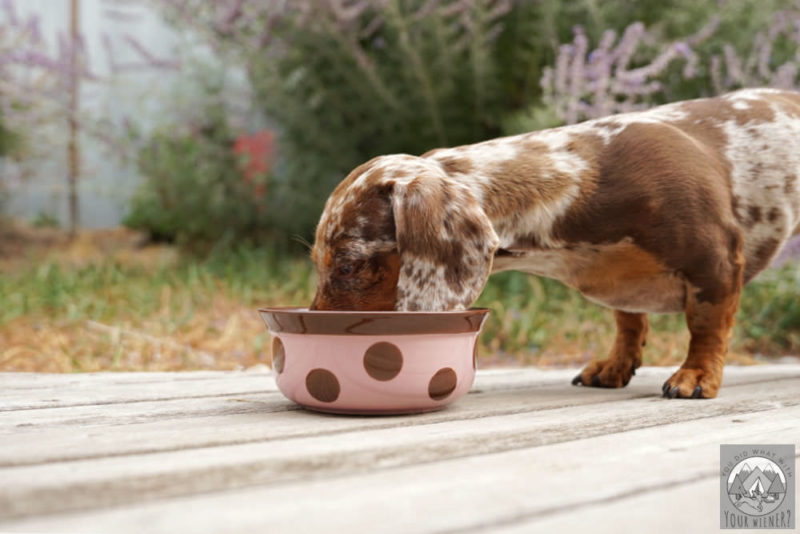
Weight loss dog foods without grain
Acana Light & Fit
Acana Light & Fit would probably be my #1 choice (or the slightly better quality, but more expensive Orijen Fit & Trim made by the same company)
ACANA Light & Fit dog food is nutrient-dense and high in protein, which is important for active Dachshunds like mine.
This biologically appropriate diet includes meat, organs, cartilage, and bone to provide needed nutrients naturally.
Regional farms Acana trusts provide the from whole free-run chicken and turkey and wild-caught fish.
Instinct Raw Boost Healthy Weight
Instinct Raw Boost Healthy Weight dry dog food combines high protein, grain free kibble with all natural bites of freeze dried raw chicken. Cage free chicken is the #1 ingredient.
It’s made without grain, potato, corn, wheat, soy, byproduct meal, artificial colors or preservatives.
This formula contains L-Carnitine to provide a fat-burning boost.
Firstmate Pet Foods Pacific Ocean Fish Senior and Weight Control
Firstmate Pet Foods Pacific Ocean Fish is a good weight control food for Dachshunds of all ages, but especially seniors.
This is a limited ingredient food, which contains fish as it’s only protein source, so it’s good for dogs with allergies to other meats like beef and chicken. Also, Fewer ingredients makes this formula easy on digestion.
If you check the ingredients list, you will see chicken fat used but FirstMate Pet Foods processes the chicken fast so it’s free of protein, eliminating the risk of allergies derived from chicken (it’s protein that sets the allergies off).
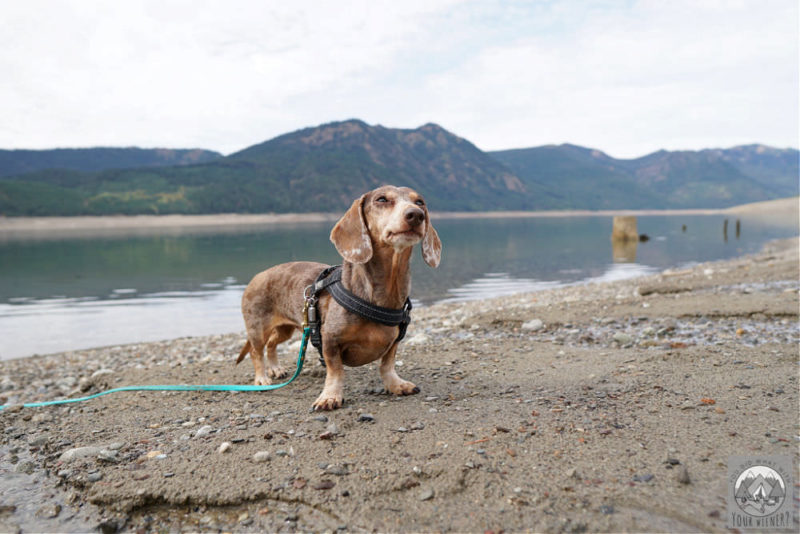
Weight loss dog foods WITH grain
Some Dachshund owners are concerned about the grain free food – Canine Dilated Cardiomyopathy (DCM) connection.
DCM occurs when the heart muscle becomes weak.
This leads to a loss of the ability to contract normally and pump blood throughout the body and eventually heart failure.
While Dachshunds are not a breed typically prime to this disease, some research has made a correlation between the development of DCM and dogs who are fed a grain free diet (specifically, those that contain legumes as a replacement) even in breeds that are not prone to the disease.
For those that would like a “grain inclusive” (the healthiest kind are barley, rice, and oats) in their Dachshund’s weight loss food, here are my top pics.
Fromm Gold Reduced Activity & Senior Dry Dog Food
Fromm Family Foods is a fifth generation family-owned-and-operated artisan pet food company.
This food is designed to be high in nutrient digestibility and utilization.
Fromm Gold Reduced Activity & Senior Dry Dog Food contains grain (rice, oats, millet, and barley) as well as chicken and Fromm’s specially developed blend of probiotics.
It doesn’t contain corn, wheat, and beet pulp (and that’s a good thing).
Nutro Ultra Small Breed Adult Weight Management
Nutro Ultra Small Breed Adult Weight Management is another weight management dog food contains grain (rice and oats) but this one comes in smaller pieces – small bites for small Dachshunds.
It features protein from chicken, lamb, and salmon. It also contains their proprietary blend of 15 superfoods like coconut, chia, kale, blueberries.
It contains no chicken byproduct meal, corn, soy, wheat, and no artificial flavors, colors or preservatives.
Exercise to Help Your Dachshund Shed Pounds
The other part of the weight loss formula is how many calories your Dachshund is burning throughout the day.
This is largely determined by their exercise level.
If your Dachshund does not go for daily walks, this is the time to start.
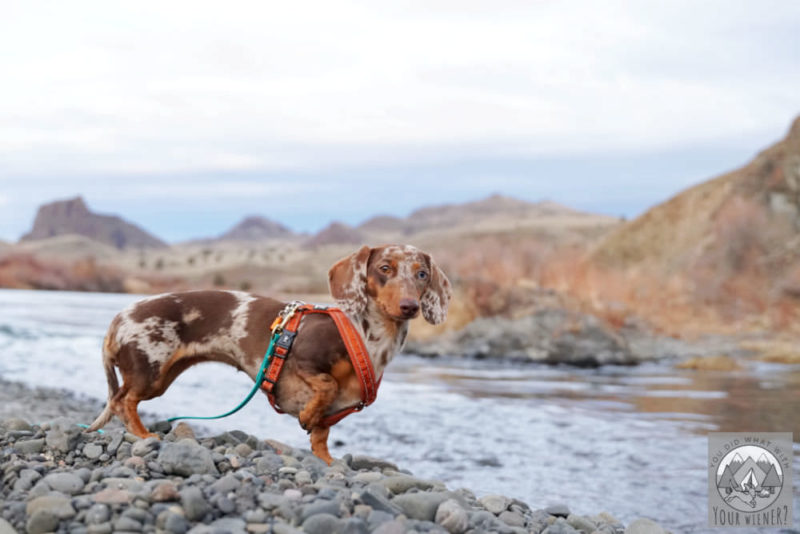
Taking your dog for a 20-30 minute walk (where your dog is actually walking, not strolling along sniffing everything) 4-5 times a week can make a big difference.
Note: If your dog has been sedentary and you want to start a new exercise routine, it’s always a good idea to check with your veterinarian first.
If your Dachshund is used to regular exercise, try increasing it by 20-30%.
For example, if you and your dog normally walk 8 miles a week (2 miles a day for 4 days), try increasing the distance walked per week by 2 miles.
This can be accomplished with one additional 2-mile walk a week or by extending the regular walks by ½ mile each time.
If you want to know more about how much exercise a Dachshund needs, please refer to these articles:
- How Much Exercise Should a Dachshund Get?
- How Many Times a Week Should I Take My Dachshund for a Walk?
- How Far Should I Walk My Dachshund Each Day We Go Out?
How to Know Your Dachshund Has Reached Their Ideal Weight
The best way to tell if your Dachshund is at a healthy weight is by look and feel.
This article outlines what a fit and healthy Dachshund should look like (pay special attention to the body condition chart).
Since each Dachshund has a slightly different frame and built, there is no hard rule for how much yours should weigh.
However, there are some rules around what a proper weight looks and feels like.
These are:
- You look at your dog’s ribs while they are standing up and you can see them and/or can easily feel them under the skin when you touch them.
- You look at your Dachshund from the side when they are standing up and their abdomen “tucks” up behind their rib cage (think Greyhound) .
- You look at your dog from above when they are standing up and your Dachshund has a defined waist (hourglass shape). In other words, their body is not just one round cylinder with, basically, straight lines from front to back.
Your goal should be to keep your Dachshund on a food reduction and/or increased exercise routine until the ideal look and feel is achieved.
Once your Dachshund has reached their ideal weight, it’s up to you to keep them there.
I keep a close watch on how my Dachshunds look and adjust their amount of food and exercise up or down as needed to stay in the “good weight” zone.
Helping Your Dachshund Shed Pounds – Final Thoughts
The two important keys to keeping your Dachshund at the proper weight (once you check with your vet to make sure there are no medical issues at play) are controlling the amount of food they eat and exercise they get.
You may want to opt for a weight loss dog food to reduce calories while maintaining the same volume of food but you don’t have to.
You can make up this extra volume with no-sodium green beans or water.
You can also just try feeding the lower volume of food because your Dachshund may not have an issue with it.
Increase your Dachshund’s level of exercise gradually but shoot for at least 20% more than you are currently doing.
Once your Dachshund returns to the proper weight for their frame and build, you may be able to increase the food, or decrease the exercise a little, and still maintain your Dachshund’s newly-fit physique.
However, that may result in your Dachshund’s weight creeping back up so you may have to revert to the same amounts of each that worked before.
Once your Dachshund is at their ideal weight, they will feel better, will be able to get around better, and will be happier.
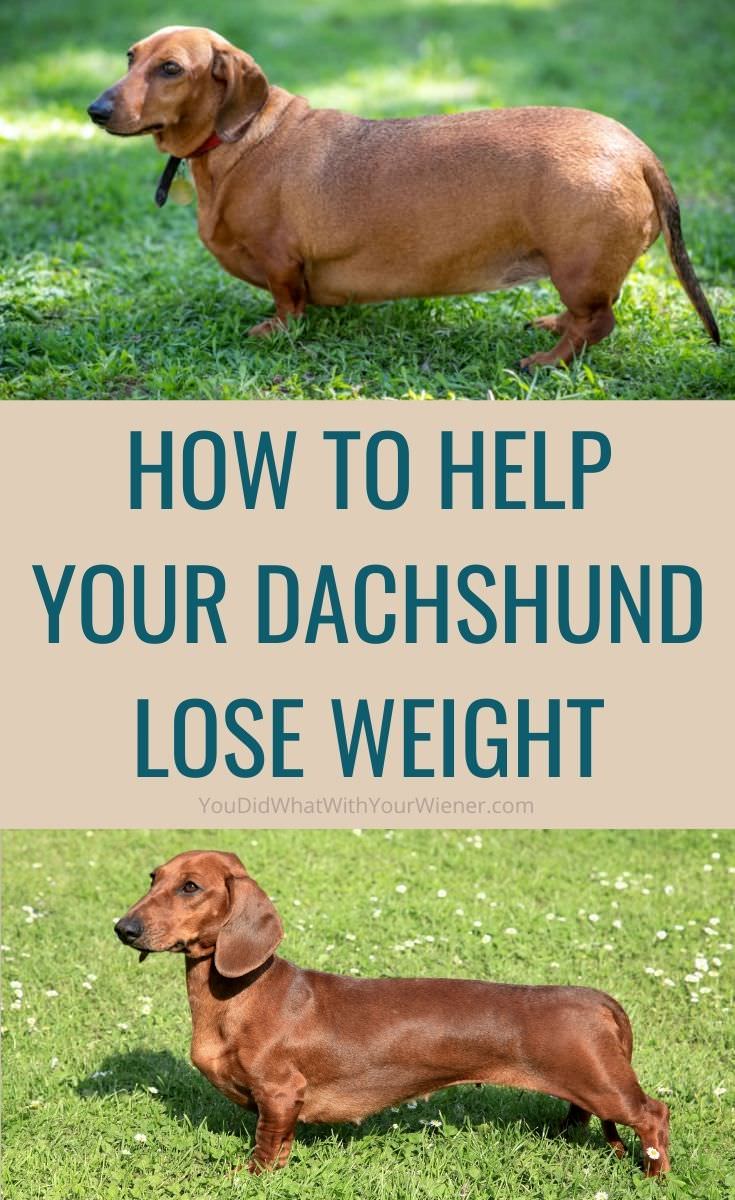

About the Author
Hi, I’m Jessica. I’ve been studying the Dachshund breed since 2007, owned 3 of my own, and shared in the lives of thousands of others through their owner’s stories. When I’m not sharing what I know on this blog, you can find me hiking, camping, and traveling with my adventurous wiener dogs.

Hi Jessica,
We met at Bark World several years ago and I have been following you since. We have a company called Let Your Love Grow, we convert cremation ash into organic matter, allowing them to live again as any type of plant. I am also doxie dad! I love this blog about monitoring or helping a doxie lose weight. Would you allow us to share this blog on our website? http://www.letyourlovegrow.com ?
Thanks,
Hi Bob. I remember talking with you. You are welcome to share my article on social media but I don’t allow it to be republished. If you would like content for your blog, please reach out to me at Jessica@pettalkmedia.com and we can discuss options. Thanks.
My boy is ten months and is eating puppy cainn. Reduced meals a cup full spread out over the day..hes 14 kg and is meant to he 10 or 11 hes a long haired standard. Its been 5 days hes doing ok but wont to give him something else reading beans is good to give what else is there..
Hi Donna. Yes, as my article mentions, adding no-sodium green beans in place of a portion of the food is a good option to reduce calories while providing a similar volume. If I don’t add beans, I use the water trick I mention. There aren’t really any other veggies as low calorie as the green beans but any dog-safe non-starchy vegetable could work. One example would be broccoli.
Hi. My dachshund is 11 years old and she is overweight. She had back surgery 4 years ago. What kind of exercise can she do? I am going to try weight loss food
HI Melissa. I don’t know your pup’s speific situation but walking is still an appropriate form of exercise with a dog that has back issues. Swimming is also a good one. Some people have their own pool or just support their dogs in a bathtub while they paddle. In some areas, there are also pool facilities specifically for dogs.
Hi,
Thank you for the helpful info! Do you have an article sharing the raw diet you feed your pups? Have you always fed your doxies raw and, if not, what led you to the change?
Thank you!
Lindsey
Hi Linsey. I do have an article about what I feed them. You can read it here: https://youdidwhatwithyourweiner.com/what-i-feed-my-active-dachshunds-to-help-keep-them-healthy/
When I switched from dry kibble to watered kibble my dog actually gained weight. She wasn’t overweight before. I’m pretty sure the nutrients in the kibble are more easily digested and available when the water is added, causing the weight gain. I’ll try your suggestion of frozen beans and reduce the amount of watered kibble.
Hi Sydney. I’ve never heard of watered kibble causing weight gain but I am not saying it couldn’t happen. Adding the water does indeed make the food easier to digest for many dogs, thus “increasing” the amount of calories eaten. Good for you for recognizing that your pup was gaining weight and taking action.
Hi,
I’m helping my dachshund to lose weight. As I’m reading your article, ain’t quite sure which type of green beans you’re referring to. Cause’ in Asia countries, green beans are mung beans. Do you mean “long green beans”? Do you have an example to show please? Thank you.
Hi Linda. I can see the confusion. I can’t share a photo here, but here is a link to a photo showing the kind of green beans that I am talking about. https://www.cascadianfarm.com/product/frozen-cut-green-beans/ They don’t have to be purchased cut to be used in your dog’s meal, but I would cut them into bite sized pieces before feeding. I hope that helps.